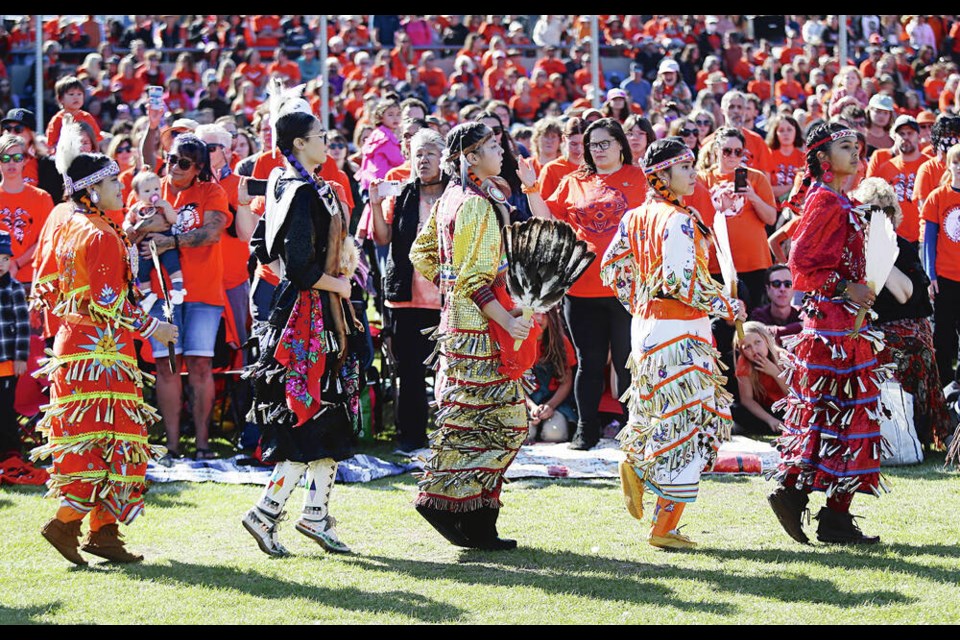As the sun began to set on Royal Athletic Park, the call went out for those who survived residential school, day school and the Sixties Scoop to join the South Island Powwow’s ceremonial dance for missing and murdered Indigenous women and girls.
Close to 200 people gathered in the centre of the powwow circle.
“The truth is slowly, slowly, coming out,” said powwow emcee Francis James, himself a survivor of the Sixties Scoop.
About 10,000 people attended the event, filled with dance, food and art to celebrate and remember the resiliency of Indigenous people on the National Day for Truth and Reconciliation.
Nipiya Napoleon, a powwow volunteer, said it was great to see both native and non-native people coming together on Saturday at Royal Athletic Park for the powwow.
Napoleon, who is Cree, said the day is as much a celebration as it is a protest. “How many years has this been swept under the rug and nobody was allowed to talk about it?”
Danny MacIntyre, of the Burns Lake Nation and Hesquiaht First Nation, said the Day for Truth and Reconciliation belongs to the children. “The ones that did not make it, the ones that we still are searching for.”
“My wife’s mom, she’s a survivor. So is my grandpa, my great-grandpa,” he said. “They’ve been abused and sexually abused, and they’re the survivors.”
Dale Whitford, who was sharing tipi teachings, said that the conversation on reconciliation must continue. “We have to come to terms and accept what happened in the past needs to be in some way addressed.”
Whitford remembers being afraid of speaking Plains Cree when growing up. “I was beat up, chased home, embarrassed by the teacher.” But today he speaks what he knows of the language proudly and shares what he knows at the Victoria Native Friendship Centre.
Victoria Mayor Marianne Alto said it was a great privilege for the city to partner with the Songhees Nation in organizing the event. “It’s so hopeful to see this many people here who at the very least are willing to come and embrace the challenge, listen to the stories and internalize that responsibility.”
Samantha Dean, a South Island Powwow committee member, said that there was more time and capacity to plan this year’s powwow compared to last year.
The previous year, organizers had to make an emergency order of 500 pizzas to sell by donation due to only having three food vendors at the event, she said, adding that this year there were 15.
Lex Edwards, a drummer with the Kamloops-based Sage Hills drum group, said he hopes the powwow becomes even larger in coming years.
Edwards, of the St’at’imc, has been in the powwow drum circuit for 27 years. ”Once I became an adult, there wasn’t anything else that I would rather do but to share my culture,” he said.
Ren Louie, an Ahousaht Nation member who danced at the powwow, said that he believes that Canada is heading in a good direction in relation to its Indigenous peoples. “The prime minister’s apologized, the Pope’s apologized, and now we have a Truth and Reconciliation Day.”
But Eddy Charlie, who has led Victoria’s Orange Shirt Day gatherings for many years, said that the story of Indigenous people’s experiences in Canada is still not being fully heard. “They’re still fighting for clean water in parts of Ontario.”
Charlie, a survivor of Kuper Island Residential School, said that B.C.’s Ministry of Children and Family Development continues to remove Indigenous children from their families into care or foster homes where they are then mistreated.
Eight South Island First Nations are working together to form their own regulations around child and family services through the South Island Indigenous Authority, but it’s still in its early stages.
Just 13 of the 94 calls to action from the Truth and Reconciliation Commission’s report have been implemented since 2015, according to a recent statement from Joanna Bernard, interim national chief of the Assembly of First Nations.
>>> To comment on this article, write a letter to the editor: [email protected]



